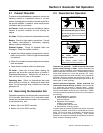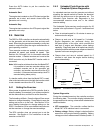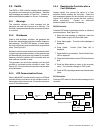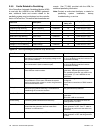
TP-6804 1/15 21Section 2 Generator Set Operation
Section 2 Generator Set Operation
2.1 Prestart Checklist
To ensure continued satisfactory operation, perform the
following checks or inspections before or at each
startup, as designated, and at the intervals specified in
the service schedule. In addition, some checks require
verification after the unit starts.
Air Cleaner. Check for a clean and installed air cleaner
element to prevent unfiltered air from entering the
engine.
Air Inlets. Check for clean and unobstructed air inlets.
Battery. Check for tight battery connections. Consult
the battery manufacturer’s instructions regarding
battery care and maintenance.
Exhaust System. Check for exhaust leaks and
blockages. Check the muffler condition.
D Inspect the exhaust system components for cracks,
leaks, and corrosion. Check for tight exhaust system
connections.
D Check forcorroded orbroken metalparts andreplace
them as needed.
D Check that the exhaust outlet is unobstructed.
Oil Level. Check the oil level before starting the
generator set and at the intervals given in Section 5,
Scheduled Maintenance. Maintain the oil level at or
near, not over, the full mark on the dipstick.
Operating Area. Check for obstructions that could
block the flow of cooling air. Keep the air intake area
clean. Do not leave rags, tools, or debris on or near the
generator set.
2.2 Exercising the Generator Set
Operate the generator set without load once each week
for 20 minutes. See Section 2.4 for information about
loaded and unloaded exercise modes. For instructions
to set the exerciser, see:
D Section 3.6 for the RDC2 controller
D Section 4.5 for the DC2 controller
2.3 Generator Set Operation
Hazardous voltage.
Can cause severe injury or death.
Operate the generator set only when
all guards and electrical enclosures
areinplace.
Moving parts.
WARNING
Carbon monoxide.
Can cause severe nausea,
fainting, or death.
The exhaust system must be
leakproof and routinely inspected.
WARNING
Generator set operation. Carbon monoxide can cause
severe nausea, fainting, or death. Carbon monoxide is an
odorless, colorless, tasteless, nonirritating gas that can cause
death ifinhaled for even ashort time. Avoid breathingexhaust
fumes when working on or near the generator set. Never
operate the generator set inside a building. Never operate the
generator set where exhaust gas could seep inside or be
drawninto apotentiallyoccupiedbuilding throughwindows,air
intake vents, or other openings.
Carbon monoxide symptoms. Carbon monoxide can
cause severe nausea, fainting, ordeath. Carbon monoxide
is a poisonous gas present in exhaust gases. Carbon
monoxideis anodorless, colorless,tasteless, nonirritatinggas
that can cause death if inhaled for even a short time. Carbon
monoxide poisoning symptoms include but are not limited to
the following:
D Light-headedness, dizziness
D Physical fatigue, weakness in
joints and muscles
D Sleepiness, mental fatigue,
inability to concentrate
or speak clearly, blurred vision
D Stomachache, vomiting, nausea
If experiencing any of these symptoms and carbon monoxide
poisoning is possible, seek fresh air immediately and remain
active. Do not sit, lie down, or fall asleep. Alert others to the
possibility of carbon monoxide poisoning. Seek medical
attention if the condition of affected persons does not improve
within minutes of breathing fresh air.


















